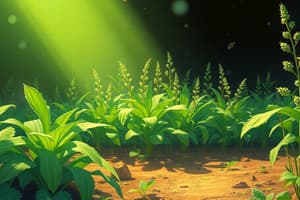Podcast
Questions and Answers
What is the first step in the plant introduction procedure?
What is the first step in the plant introduction procedure?
- Multiplication and distribution
- Plant procurement or procurement of Germplasm (correct)
- Entry and plant quarantine
- Evaluation
Which of the following describes a propagule?
Which of the following describes a propagule?
- A type of weed seed
- An insect or disease affecting plants
- The part of the plant used for propagation (correct)
- A process of plant evaluation
What is the purpose of entry inspection during the plant introduction process?
What is the purpose of entry inspection during the plant introduction process?
- To clean the propagules from contaminants
- To evaluate resistance to pests
- To check for insects, diseases, and nematodes (correct)
- To catalog the introduced specimens
After the quarantine process, what is done to the plant specimens?
After the quarantine process, what is done to the plant specimens?
How are the introduced plant materials classified post-quarantine?
How are the introduced plant materials classified post-quarantine?
What is one way plant material can be obtained for introduction?
What is one way plant material can be obtained for introduction?
What is the main purpose of plant introduction?
What is the main purpose of plant introduction?
What is the primary goal of plant quarantine measures?
What is the primary goal of plant quarantine measures?
Which of the following best describes primary introduction?
Which of the following best describes primary introduction?
What does the evaluation step in plant introduction involve?
What does the evaluation step in plant introduction involve?
What is the process of making wild species suitable for cultivation called?
What is the process of making wild species suitable for cultivation called?
Which of the following factors does NOT influence the success of acclimatization?
Which of the following factors does NOT influence the success of acclimatization?
Which of the following is considered a secondary introduction?
Which of the following is considered a secondary introduction?
What role does germplasm conservation play in plant introduction?
What role does germplasm conservation play in plant introduction?
Which of the following is NOT a factor contributing to acclimatization?
Which of the following is NOT a factor contributing to acclimatization?
Why is the introduction of ornamental plants emphasized?
Why is the introduction of ornamental plants emphasized?
What is the primary role of the National Bureau of Plant Genetic Resources (NBPGR)?
What is the primary role of the National Bureau of Plant Genetic Resources (NBPGR)?
Which substation under NBPGR is dedicated to the arid zone?
Which substation under NBPGR is dedicated to the arid zone?
What is a crucial merit of plant introduction?
What is a crucial merit of plant introduction?
Which substation supports acclimatization in the northern hills?
Which substation supports acclimatization in the northern hills?
Which of the following agencies focuses on the introduction of medicinal plants?
Which of the following agencies focuses on the introduction of medicinal plants?
What does the substation at KanyaKumari primarily represent?
What does the substation at KanyaKumari primarily represent?
Which agency is responsible for the testing and conservation of forest trees?
Which agency is responsible for the testing and conservation of forest trees?
How does plant introduction economically benefit crop improvement?
How does plant introduction economically benefit crop improvement?
What is one major disadvantage of plant introduction?
What is one major disadvantage of plant introduction?
Which of the following crops was introduced to India from other countries?
Which of the following crops was introduced to India from other countries?
Which insect pest was introduced in India along with plant introduction?
Which insect pest was introduced in India along with plant introduction?
What method is used to improve introduced plant varieties that lack certain desirable characteristics?
What method is used to improve introduced plant varieties that lack certain desirable characteristics?
Which dwarf wheat variety was introduced in India?
Which dwarf wheat variety was introduced in India?
What is a potential benefit of using introduced varieties in hybridization programs?
What is a potential benefit of using introduced varieties in hybridization programs?
Which of the following is an example of indirect multiplication leading to new crop varieties?
Which of the following is an example of indirect multiplication leading to new crop varieties?
What was a significant issue during the introduction of weeds and diseases in India?
What was a significant issue during the introduction of weeds and diseases in India?
Flashcards are hidden until you start studying
Study Notes
Plant Introduction: Purpose and Procedure
- Plant Introduction: The process of introducing plants (a genotype or a group of genotypes) from their native environment to a new environment
- Primary Introduction: Introducing varieties that are immediately well-suited to the new environment, without genetic alteration. Examples: Dwarf wheat varieties like 'Sonora-64', 'Lerma rojo' and dwarf rice varieties like 'Taichung Native 1', 'IR-8'
- Secondary Introduction: Introducing varieties that require selection or hybridization with local varieties to improve traits. Examples: Wheat varieties 'Kalyan Sona' and 'Sonalika'
- Domestication: The process of bringing a wild species under cultivation by making them suitable for a new environment.
- Acclimatization: The adaptation process of a crop to a new climate and soil conditions.
- Factors affecting acclimatization: Breeding system, Genetic variation, Crop duration
- Factors influencing acclimatization success: 'Place effect' and selection of new genotypes.
Purpose of Plant Introduction
- Agricultural, Forestry, and Industrial Uses: Introduce new plants or crops for food, fiber, wood, medicinal purposes, and breeding materials for hybridization.
- Aesthetic Interest: Introduction of ornamental plants for beautification
- Germplasm Conservation: Maintaining older plant varieties threatened by the spread of high-yielding varieties.
- Studying Origin and Distribution: Understanding the origin and evolution of crop plants through their distribution and forms in different parts of the world.
Procedure of Plant Introduction
- Plant Procurement or Germplasm Acquisition:
- Submit requests for the introduction of new crop plants or varieties to:
- NBPGR (National Bureau of Plant Genetic Resources) - Within the country
- IBPGR (International Bureau of Plant Genetic Resources) - Globally
- Acquire materials through exchange programs, purchases, or gifts with/from friendly countries, individuals, or organizations.
- Submit requests for the introduction of new crop plants or varieties to:
- Packaging and Despatch:
- Ensure the viability of propagule (seeds, tubers, runners, etc.) depending on the species.
- Thoroughly clean propagules to remove contaminants, weed seeds, etc.
- Treat with fungicides and pack carefully for safe delivery.
- Entry and Plant Quarantine:
- Upon arrival, the material is inspected to prevent the entry and spreading of pests, diseases, and nematodes.
- Treated with insecticides, fungicides, or nematicides before being released to the user.
- Cataloguing:
- Introduced plants are given a unique number based on species, variety, and origin.
- Plant materials are classified into three groups:
- Exotic Collection -- prefix 'EC'
- Indigenous Collection -- designated as 'TC'
- Indigenous Wild Collection -- marked as 'TW'.
- Evaluation:
- The performance of the introduction is assessed at various substations for:
- Yield potential in different environments
- Resistance to diseases and pests
- The performance of the introduction is assessed at various substations for:
- Multiplication and Distribution:
- Promising introduced materials are propagated and released as new varieties after undergoing trials.
Agencies of Plant Introduction in India
- National Bureau of Plant Genetic Resources (NBPGR) - The central agency with headquarters in New Delhi and substations.
- Functions: Gene bank for long-term storage, assessment of introduced materials, coordination of other agencies, and training in plant introduction, collection, and maintenance.
- Substations under NBPGR:
- Shimla: Represents the temperate zone (2300m) for germplasm collection, acclimatization of temperate zone materials.
- Jodhpur: Focused on exploring and acclimatizing plants for arid zones under CAZRI (Central Arid Zone Research Institute).
- Amravati: Acclimatization and multiplication of introductions for the central zone of India.
- KanyaKumari: Represents the tropical zone in South India.
- Shillong: Collection of germplasm from North-East India.
- Other Agencies:
- Forest Research Institute, Dehradun: Introduction, acclimatization, conservation, and testing of forest trees.
- Botanical Survey of India: Introduction of medicinal and botanically important plants.
- Central Research Institutes and Agricultural Universities: Play a role in collecting, introducing, and maintaining germplasm of crop plants.
Merits and Demerits of Plant Introduction
Merits:
- Provides entirely new crop plants to a region.
- Superior varieties may be originated directly or through selection or hybridization.
- Germplasm collection, maintenance, and protection of genetic variability are possible.
- The quickest and most economical method of crop improvement when introduced materials can be used directly.
- Introduction of some varieties to new areas might protect them from diseases.
Demerits:
- Introduction of weeds, diseases, and pests:
- Weed examples: Argemone, Eichhornia, Lantana
- Fungal diseases: Late blight of potato, flat smut of wheat, coffee rust, bunchy top of banana
- Insect pests: Potato tuber moth, woolly aphis of apple, fluted scale of Citrus
Achievements of Plant Introduction
- Introduction of new crop species to the world:
- Potato, maize, groundnut, chillies, coffee, rubber, guava, grape, pineapple, and ornamentals like Gulmohor, Phlox, Salvia, Aster
- Development of new crop varieties:
- Direct Multiplication: Dwarf wheat varieties like 'Sonora 64', 'Lerma Rojo' and dwarf rice varieties like 'TN-1', 'IR-8'
- Selection of Desirable Varieties: 'Kafyan Sona', 'Sonalika' from Mexican wheat varieties
- Donor in Hybridization Programmes: Introduced varieties with superior traits used for disease resistance, pest resistance, stress resistance, plant type, and quality.
- Examples: Dwarfing gene from TN-1 or IR-8 in rice, noble cane variety Saccharum officinarum for sugarcane
- Mutation Breeding: Modification of introduced material (agronomically superior but lacking certain traits) with mutagens to rectify defects.
Studying That Suits You
Use AI to generate personalized quizzes and flashcards to suit your learning preferences.




